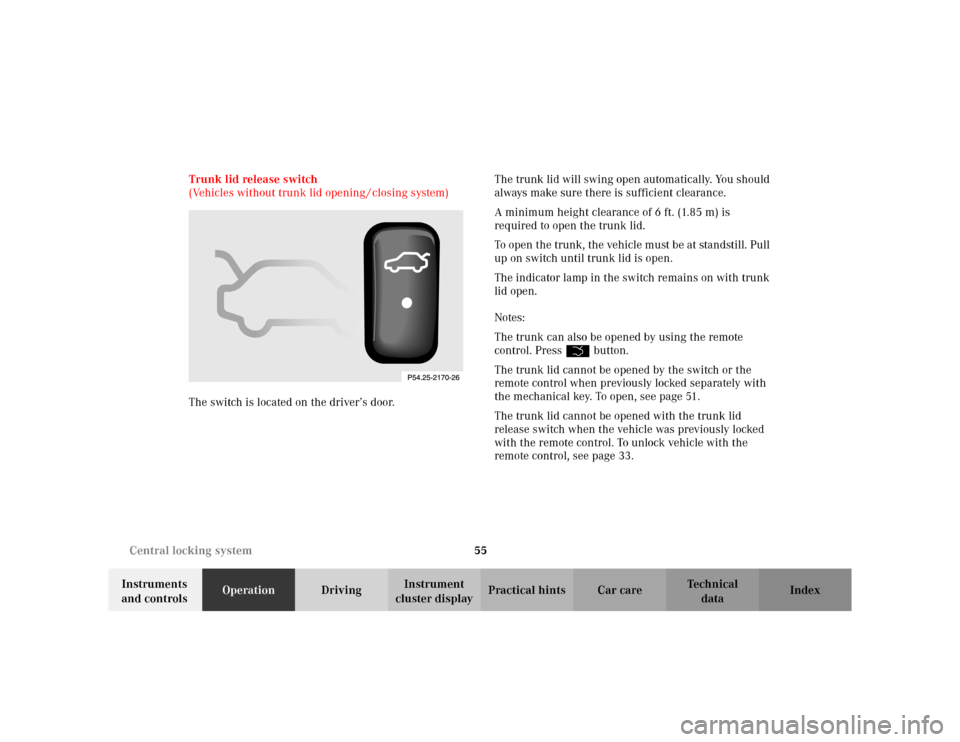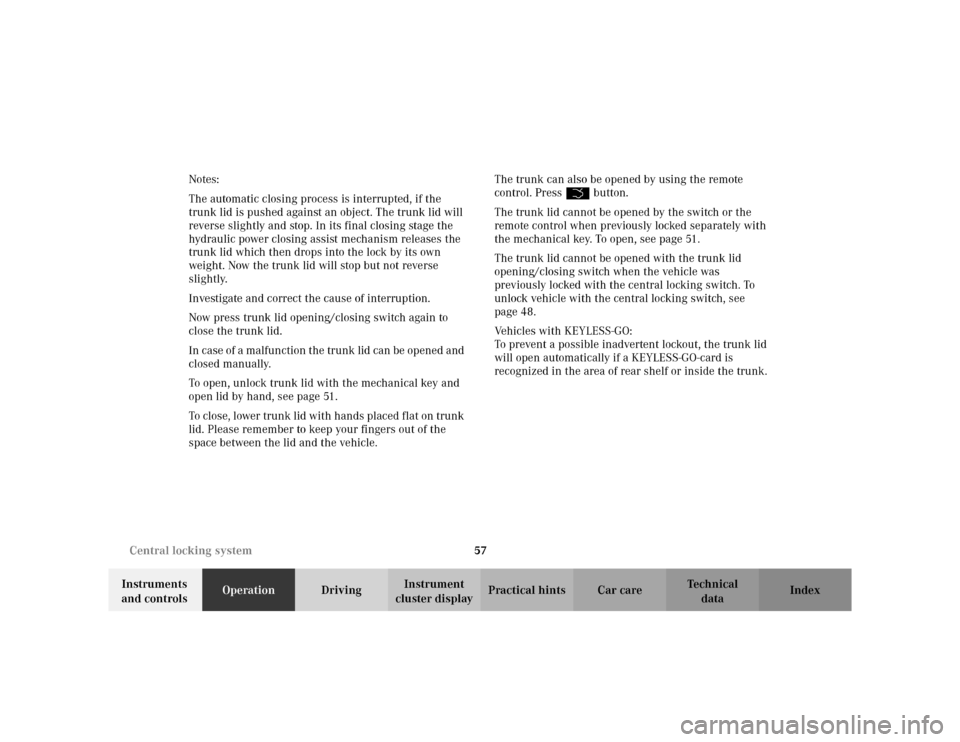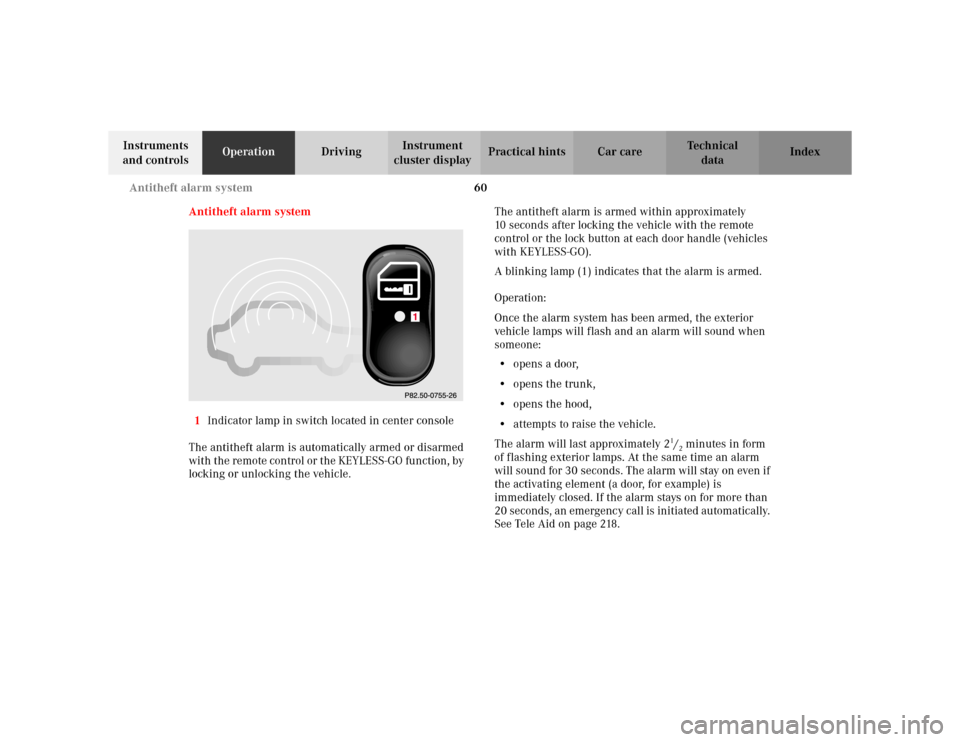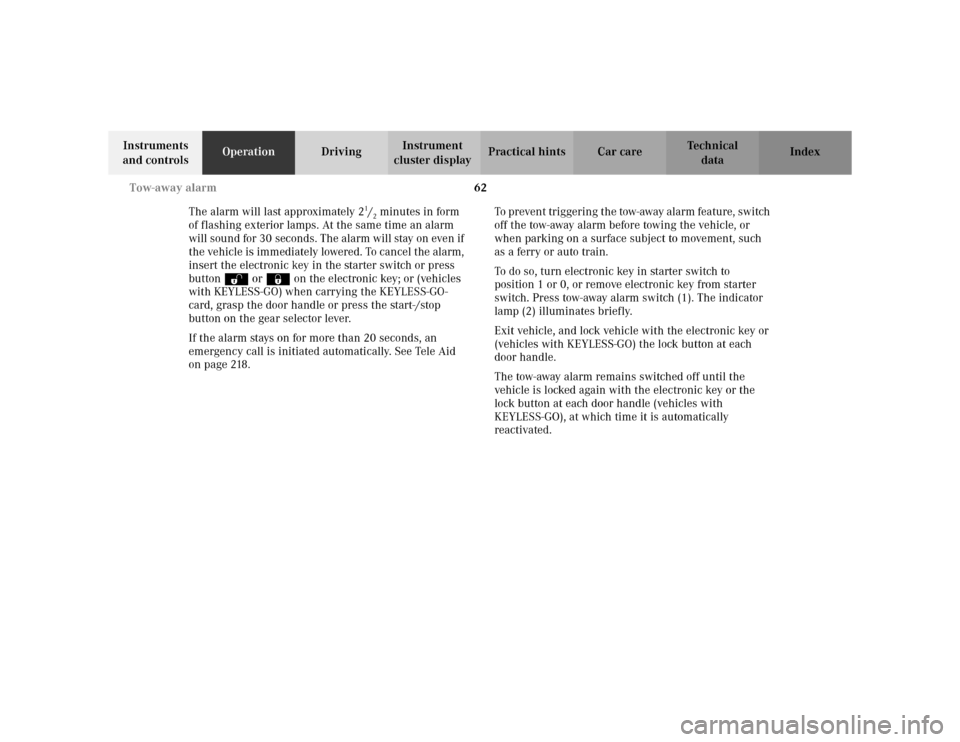Page 56 of 430

53 Central locking system
Te ch n i c a l
data Instruments
and controlsOperationDrivingInstrument
cluster displayPractical hints Car care Index Vehicles with trunk lid opening / closing system:
Press trunk lid button (2) briefly. The trunk lid closes
automatically.
The trunk lid can also be closed with the trunk lid
opening / closing switch located on the driver’s door, see
page 56.Notes:
The automatic closing process is interrupted if the
trunk lid is pushed against an object. The trunk lid will
reverse slightly and stop. In its final closing stage the
hydraulic power closing assist mechanism releases the
trunk lid which then drops into the lock by its own
weight. Now the trunk lid will stop but not reverse
slightly.
Investigate and correct the cause of interruption.
Now press trunk lid button (2) again to close the trunk
lid.
P54.25-2403-26
Wa r n i n g !
To prevent possible personal injury, always keep
hands and fingers away from the trunk opening
when closing the trunk lid. Be especially careful
when small children are around.Always be sure persons who might get injured are
away from the trunk area when you operate the
trunk closing button located on the vehicle door.To interrupt the hydraulic power closing assist
mechanism press trunk lid close button (2) inside
the trunk lid, push in trunk lid lock or press
buttonŠ on the electronic key.
Page 57 of 430
54 Central locking system
Te ch n i c a l
data Instruments
and controlsOperationDrivingInstrument
cluster displayPractical hints Car care Index
In case of a malfunction the trunk lid can be opened and
closed manually.
To open, unlock trunk lid with the mechanical key and
open lid by hand, see page 51.
To close, lower trunk lid with hands placed flat on trunk
lid. Please remember to keep your fingers out of the
space between the lid and the vehicle.
Vehicles with KEYLESS-GO:
To prevent a possible inadvertent lockout, the trunk lid
will open automatically if a KEYLESS-GO-card is
recognized in the area of the rear shelf or inside the
trunk.Trunk lamp
The trunk lamp will switch off after approximately
10 minutes if the trunk lid is left open.
Page 58 of 430

55 Central locking system
Te ch n i c a l
data Instruments
and controlsOperationDrivingInstrument
cluster displayPractical hints Car care Index Trunk lid release switch
(Vehicles without trunk lid opening / closing system)
The switch is located on the driver’s door.The trunk lid will swing open automatically. You should
always make sure there is sufficient clearance.
A minimum height clearance of 6 ft. (1.85 m) is
required to open the trunk lid.
To open the trunk, the vehicle must be at standstill. Pull
up on switch until trunk lid is open.
The indicator lamp in the switch remains on with trunk
lid open.
Notes:
The trunk can also be opened by using the remote
control. Press Šbutton.
The trunk lid cannot be opened by the switch or the
remote control when previously locked separately with
the mechanical key. To open, see page 51.
The trunk lid cannot be opened with the trunk lid
release switch when the vehicle was previously locked
with the remote control. To unlock vehicle with the
remote control, see page 33.
Page 60 of 430

57 Central locking system
Te ch n i c a l
data Instruments
and controlsOperationDrivingInstrument
cluster displayPractical hints Car care Index Notes:
The automatic closing process is interrupted, if the
trunk lid is pushed against an object. The trunk lid will
reverse slightly and stop. In its final closing stage the
hydraulic power closing assist mechanism releases the
trunk lid which then drops into the lock by its own
weight. Now the trunk lid will stop but not reverse
slightly.
Investigate and correct the cause of interruption.
Now press trunk lid opening/closing switch again to
close the trunk lid.
In case of a malfunction the trunk lid can be opened and
closed manually.
To open, unlock trunk lid with the mechanical key and
open lid by hand, see page 51.
To close, lower trunk lid with hands placed flat on trunk
lid. Please remember to keep your fingers out of the
space between the lid and the vehicle.The trunk can also be opened by using the remote
control. PressŠ button.
The trunk lid cannot be opened by the switch or the
remote control when previously locked separately with
the mechanical key. To open, see page 51.
The trunk lid cannot be opened with the trunk lid
opening/closing switch when the vehicle was
previously locked with the central locking switch. To
unlock vehicle with the central locking switch, see
page 48.
Ve h i c l e s w i t h K E Y L E S S - G O :
To prevent a possible inadvertent lockout, the trunk lid
will open automatically if a KEYLESS-GO-card is
recognized in the area of rear shelf or inside the trunk.
Page 63 of 430

60 Antitheft alarm system
Te ch n i c a l
data Instruments
and controlsOperationDrivingInstrument
cluster displayPractical hints Car care Index
Antitheft alarm system
1Indicator lamp in switch located in center console
The antitheft alarm is automatically armed or disarmed
with the remote control or the KEYLESS-GO function, by
locking or unlocking the vehicle.The antitheft alarm is armed within approximately
10 seconds after locking the vehicle with the remote
control or the lock button at each door handle (vehicles
with KEYLESS-GO).
A blinking lamp (1) indicates that the alarm is armed.
Operation:
Once the alarm system has been armed, the exterior
vehicle lamps will flash and an alarm will sound when
someone:
•opens a door,
•opens the trunk,
•opens the hood,
•attempts to raise the vehicle.
The alarm will last approximately 2
1/2minutes in form
of flashing exterior lamps. At the same time an alarm
will sound for 30 seconds. The alarm will stay on even if
the activating element (a door, for example) is
immediately closed. If the alarm stays on for more than
20 seconds, an emergency call is initiated automatically.
See Tele Aid on page 218.
Page 65 of 430

62 Tow-away alarm
Te ch n i c a l
data Instruments
and controlsOperationDrivingInstrument
cluster displayPractical hints Car care Index
The alarm will last approximately 2
1/2minutes in form
of flashing exterior lamps. At the same time an alarm
will sound for 30 seconds. The alarm will stay on even if
the vehicle is immediately lowered. To cancel the alarm,
insert the electronic key in the starter switch or press
buttonŒ or‹ on the electronic key; or (vehicles
with KEYLESS-GO) when carrying the KEYLESS-GO-
card, grasp the door handle or press the start-/stop
button on the gear selector lever.
If the alarm stays on for more than 20 seconds, an
emergency call is initiated automatically. See Tele Aid
on page 218.To prevent triggering the tow-away alarm feature, switch
off the tow-away alarm before towing the vehicle, or
when parking on a surface subject to movement, such
as a ferry or auto train.
To do so, turn electronic key in starter switch to
position 1 or 0, or remove electronic key from starter
switch. Press tow-away alarm switch (1). The indicator
lamp (2) illuminates briefly.
Exit vehicle, and lock vehicle with the electronic key or
(vehicles with KEYLESS-GO) the lock button at each
door handle.
The tow-away alarm remains switched off until the
vehicle is locked again with the electronic key or the
lock button at each door handle (vehicles with
KEYLESS-GO), at which time it is automatically
reactivated.
Page 69 of 430
66 Seats
Te ch n i c a l
data Instruments
and controlsOperationDrivingInstrument
cluster displayPractical hints Car care Index
6Head restraint
The height of the head restraint is adjusted
automatically with the seat so that the back of the
head is supported approximately at ear level. Adjust
the head restraint using the switch if the preset
position does not support the back of your head
approximately at ear level.
For steering wheel adjustment, see page 102;
rear view mirror, see page 103;
exterior rear view mirrors, see page 104.Adjust the head restraint angle (1) by hand. Push or pull
the head restraint in direction of arrow.
Storing seat positions
The head restraint, steering wheel and rear view mirror
position are stored together with the seat position.
See page 108 for notes on the memory function. For
recalling a stored seat / head restraint / steering wheel /
and rear view mirror position see page 109.
1
Page 70 of 430

67 Seats
Te ch n i c a l
data Instruments
and controlsOperationDrivingInstrument
cluster displayPractical hints Car care Index Important!
Prior to operating the vehicle, the driver should adjust
the seat height for proper vision as well as fore/aft
placement and backrest angle to insure adequate
control, reach, operation, and comfort. The head
restraint should also be adjusted for proper height. See
also airbag section on page 91 for proper seat
positioning.
In addition, also adjust the steering wheel to ensure
adequate control, reach, operation, and comfort.
Both the inside and outside rear view mirrors should be
adjusted for adequate rearward vision.
Fasten seat belts. Infants and small children should be
seated in a properly secured restraint system that
complies with U.S. Federal Motor Vehicle Safety
Standard 213 and Canadian Motor Vehicle Safety
Standard 213.
All seat, head restraint, steering wheel, and rear view
mirror adjustments as well as fastening of seat belts
should be done before the vehicle is put into motion.
Wa r n i n g !
Children 12 years old and under must never ride in
the front seat, except in a Mercedes-Benz
authorized BabySmart
TM compatible child seat,
which operates with the BabySmart
TM system
installed in the vehicle to deactivate the passenger-
side front airbag when it is properly installed.
Otherwise they will be struck by the airbag when it
inflates in a crash. If this happens, serious or fatal
injury will result.
According to accident statistics, children are safer
when properly restrained in the rear seating
positions than in the front seating positions.
Infants and small children must ride in back seats
and be seated in an appropriate infant or child
restraint system, which is properly secured with
the vehicle’s seat belt, fully in accordance with the
child seat manufacturer’s instructions.A child’s risk of serious or fatal injuries is
significantly increased if the child restraints are
not properly secured in the vehicle and the child is
not properly secured in the child restraint.